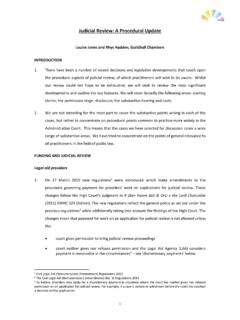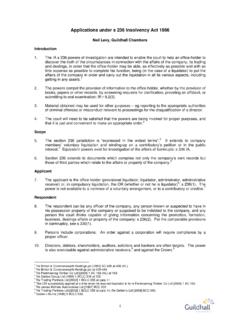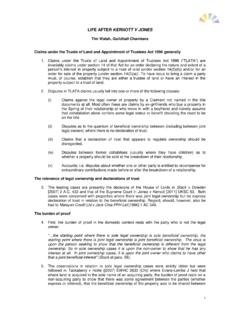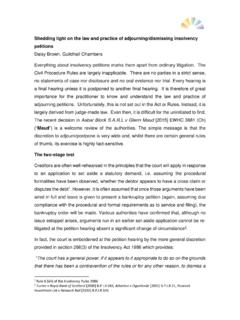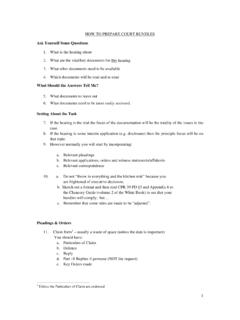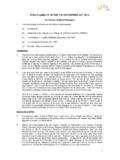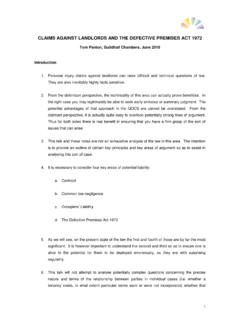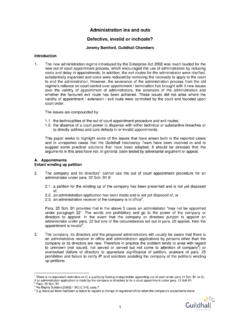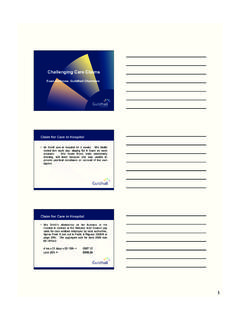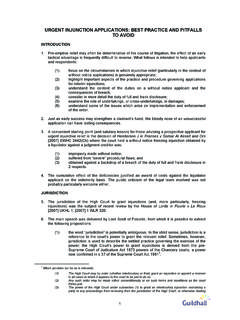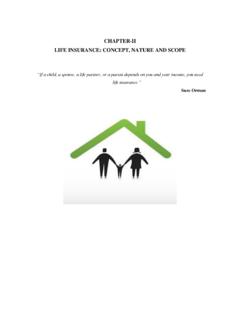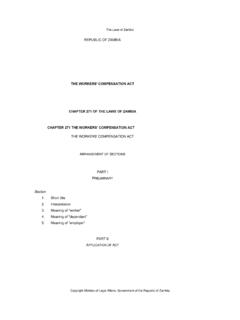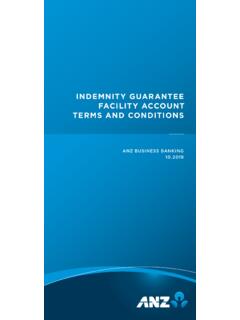Transcription of MAKING MULTIPLIERS WORK FOR YOUR CLIENT …
1 Guildhall Chambers Personal Injuries Claimant Seminar th 11 November 2010. MAKING MULTIPLIERS WORK FOR YOUR CLIENT . WORKSHOP ANSWERS. Adam Chippindall, Gabriel Farmer and Sophie Holme, Guildhall Chambers BASIC USE OF MULTIPLIERS . st st st C was born on the 1 June 1975. He was injured on the 1 December 2009. The trial is on 1. December 2010. He can work still as a brick layer but now he is part-time. The medical reports agree that he will not be able to work beyond 55. One of his injuries was to his right ankle and the experts have agreed that he will need orthotics, for life which will cost him about 75 each year and he will also need to visit the specialist for re- measurement every 3 years for the next 30 years at a cost of 100 per visit. He would have retired at 65. For these purposes ignore contingencies other than mortality . 1. Which of the Ogden Tables would you use to find the appropriate MULTIPLIERS ?
2 [Because you are dealing with a future loss, always advise your CLIENT about Periodical Payment Orders]. C will be 35 at trial so interpolation between ages 35 and 36 is required. The rate of return is set at Table 1 Loss for life: [ + ] 2 = Table 5 Earnings to age 55: [ + ] 2 = Table 9 Earnings to age 65: [ + ] 2 = Table 21 Loss of pension from age 65: [ + ] 2 = Table 28 Term certain: 30 years = NB, given retirement would have been at 66 it is necessary to interpolate between tables, hence use of two tables is required for earnings and pension see below. 2. What multiplier do you arrive at for his loss of earnings claim? Loss of earnings from 35 to 65 = [ + ] 2 = Loss of earnings from 35 to 55 = [ + ] 2 = 3. What multiplier do you arrive at for his cost of orthotics claim? Loss for life [ + ] 2 = 1. 4. What multiplier do you arrive at for his cost of measurement claim? (a) [simple calculation ]. Work out annual cost x 100 per annum for measurement.
3 Then simply apply Table 28 to the term of 30 years as above. x = (b) [periodic multiplier Table A5]. n = 30 years, table, frequency =3. Multiplier = 100 x = 681. Observations: (i) Method (a) is: simpler and gives a higher figure! routinely accepted in equipment claims;. uses a multiplier (as opposed to a fixed number of years) so is amenable for life calculations or calculations to a particular age where the table easily produce a multiplier. (ii) Method (b) is: more accurate;. and therefore more appropriate in higher value claims; and complex if not based on fixed years but a multiplier where mortality needs to be accounted for (see paras 9 and 10 of the notes to Table A5). (iii) In particularly high value cases (falling short of PPO) the discount for accelerated receipt for each individual payment would be calculated separately in order to account for (a) the time in the year when the payment would be made and (b) death falling between payments at the end of life.
4 5. How do you calculate the multiplier for his loss of pension? (a) Work out the reduced amount of his net annual pension loss from age 65 ( 5000. ). (b) Use the multiplier from Table 21 as above. x 5000 = 35,275. Observations: (i) What if the retirement age was 66? See paras 13 & 14 of the Notes to the Ogden Tables: interpolation is required. The calculation is complicated but simply work through the steps in the guidance. 1. R = 66; A = 65; B = 70. 2. A = ( + 65 - 66) = 3. M = ( from T21 = + 2 = 4. B = ( + 70- 66) = 5. N = from T23 = + 2 = 6. (70 66) x + (66 - 65) x [(70 - 66) + (66 - 65)] = 2. Simple, but less accurate alternative: take the interpolative figures from Tables 21 & 23 ( & ). The difference is which is an annual figure of ; subtract that from the lower, Table 21 figure - - =. Now assume that his right ankle injury was much more serious, so that he is unable to walk very far without having to rest; he cannot stand for long periods (more than 15 minutes) and is in pain.)
5 He is about to undergo an arthodesis, which will fuse his ankle and mean that he can walk almost normally, and stand without pain. 6. How do you assess the discount for contingencies other than mortality ? (a) Look up (paras 35 et seq. Notes to the Ogden Tables) the following: Employment status: employed or not employed;. (here C was and will be employed). Disability status: disabled/not disabled;. (here C was not disabled but now is disabled). Educational attainment. (here assume O ). (b) In calculating lost earnings it is necessary to calculate (i) what C would have earned and then deduct (ii) what he will earn. (c) So, in assessing what he would have earned use table A, 35-39, O, employed = (d) And in assessing what he will now earn,use table B, 35-39, O, employed = (e) The calculation incorporating contingencies other than mortality is therefore as follows: Would have earned (say) 20,000 x x = 361,162 LESS.
6 Will earn (say) 10,000 x x = 59,377 = 301,785. However, now assume that just before trial evidence emerges that there is a 75% chance that he will be made redundant in the year after the trial. Assume that the Defendant agrees that he qualifies for a Smith v Manchester payment to cover this risk. 7. Can the Ogden Tables assist with assessing such an award, and if so how? The Claimant's residual earning capacity was 10,000 x x = 59,377. However, if the Claimant was out of work at trial his contingencies other than mortality would have been calculated under table B as 35-39, O, Not employed = thereby producing 10,000 x x = 30,340. some 28,927 less. So, if the differential between employed and not employed is 28,927 you can argue that C should qualify for 75% of this differential in order to compensate him for the risk of redundancy. 75% x 28,927 = 21,695. Now assume that C died in the accident and the claim is being brought by his widow (aged 30.)
7 At his death). The post mortem revealed that C was otherwise healthy. There are 2 children aged 6 and 3 at his death. The widow did not work. 8. How do you calculate the multiplier for: 3. a) loss of financial dependency (we will ignore contingencies other than mortality ).;. b) loss of services dependency (assuming he did nothing for his wife)? MULTIPLIERS under the FAA 1976 must be calculated from the date of death (Cookson v Knowles [1976]. AC 556) rather than from the date of trial. C was at his death. a) Consider the age of the relevant dependant. This is because the dependency will only last for the lesser of the two periods: from death to when the deceased would have provided the dependency; from death to when the dependant would have been in receipt of that dependency. if the only dependant was a Widow aged 50 then the multiplier for the deceased (@ 0%) would be , for the widow would be - therefore the dependency would only last for her lifetime.
8 In our scenario the crucial multiplier is that of the deceased. Because there is a pension the multiplier will last for his lifetime. Facts & Figures can be confusing. There are Life Tables based on historic data, a Life Table based on projected mortality, and Tables 1 & 2 include mortality rates for the UK ( including the less favourable mortality of the Scots and Northern Irish). Historic Table = years (A3 - + 2). Expectation of Life Table (next page in F&F) = T1 (@0% Male) = If use life expectation figure ( ) then must apply Table 28 to that figure, to take into account the so-called discount rate (for accelerated receipt ) of =. NB. This figure does not include the risk of mortality between death and actual death and death but for the accident; it assumes survival to age 85. 95. ( + ). Cf. with Table 1 @ for a year old which is where mortality - the risk of death - has been included. The fun bit is in dividing it up into the various segments (because the dependency changes): 1.
9 Death to trial, which effectively is treated as past loss ;. 2. from trial to the date when the youngest child ceases being dependant (perhaps 16; 18; or after University; or 21?). If we assume to age 21 that would have been a period of 17 years (21 - 4). 3. from that date to his expected retirement at age 66 which would have been (66 - ). 4. from that date to his expected death, but for the accident. We need to take the chronological time and covert that into a multiplier; so, the total period is years. No. of years T28. 1. 1 2. 17 (18 - a) - = 3. ( - b) - = 4. ( - c) - = 4. b) His services for his children would have stopped when they reached 21. Assume, for the sake of argument, that he provided an average of 100 when there were two children at home and an average of 50 for the remaining child. From death the period certain is 15 years for the older child and 17 years for the younger. The total multiplier from T 28 is Of the 17 years 15 would have been at 100, which is 88% of the time.
10 X 88% = can be ascribed to the 100 and to the 50. 5. WHAT ABOUT CONTINGENCIES OTHER THAN MORTALITY? Anyone (!) can pick a base multiplier from a table once they know how. However, there is a huge gap between picking your base multiplier and predicting (a) how best to present and plead the claim and (b) what you will actually be awarded. The answer to these two questions is bound up in understanding: (a) How the base MULTIPLIERS are discounted for contingencies other than mortality ( the use of the Tables A,B,C and D of Ogden 6);. (b) The effect and practical consequences of a Claimant's Educational Attainment;. (c) The effect and practical consequences of a Claimant's Disability;. (d) The effect and practical consequences of a Claimant's Employment Status. The answers lie in: (a) Knowing what the Odgen 6 introductory note provide;. (b) Understanding what has been going on, on the ground;. (c) Understanding the criticisms of some of the decisions made.
